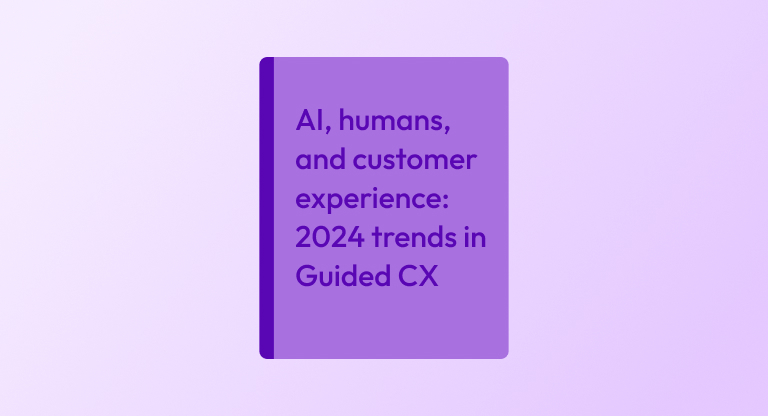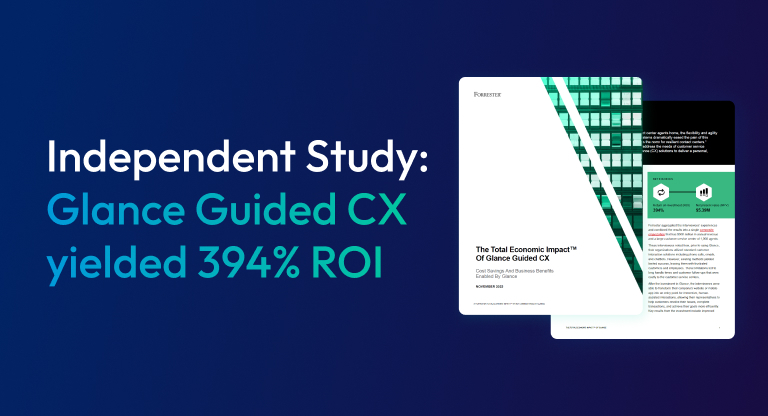
Originally published in BAI Banking Strategies
By Tom Martin, CEO, Glance
April 17, 2020
There’s little debate that automated self-service technology has captured the imagination of financial service providers. Banks, credit unions, lenders, wealth management firms and other providers of all sizes and geographies are scrambling to deploy digital customer service solutions into their contact centers and customer service organizations.
These technologies can help financial institutions increase productivity, lower operating costs, build brand loyalty and satisfy escalating consumer demand for multiple customer service channels.
From the financial services provider’s perspective, automating certain customer service functionalities makes complete sense. Some of the more basic tasks—such as resetting passwords or reviewing account balances—can quickly and easily be accomplished by the customer without any involvement from a contact center representative. Any time a customer can get faster access to the information they want—in the manner they choose—without having to invest the time and trouble of speaking with an agent or representative, that certainly bodes well for the consumer.
But while simple tasks can easily be managed in a self-service world, the situation becomes more fluid when the customer has more complex needs. For example, consumers applying for a mortgage will most likely have specific questions about various products, approval processes, documentation or other questions. A chatbot is not programmed to provide this level of detail, forcing the customer to escalate the conversation. This usually means calling the contact center, waiting on hold, and then restating their entire situation to an agent. It is time-consuming, frustrating and often ends with the customer abandoning the process altogether.
Consumers demand a frictionless and satisfying experience—regardless of whether they use an app, browser, or even voice. Their objective is to obtain information, have questions answered, and resolve problems—as efficiently, securely and conveniently as possible.
The mobile app conundrum
Self-service in browser-based banking apps on a laptop or desktop computer can certainly frustrate customers who may not find the information or functionality they want. But the issue becomes even more pronounced in mobile environments. The constraints of screen size, connectivity and limited functionality—combined with high user expectations—can translate into substandard experiences for consumers.
The importance of mobile-centric customer service solutions as part of digital customer service is undeniable. According to ABA’s research, 76 percent of American consumers have used their mobile banking apps in the past month, with 46 percent using the app three times in the past 30 days. Those are compelling numbers.
Gartner says that 84 percent of consumers find these interactions less than what they anticipated. The app has taken on increased prominence for service delivery—nearly every bank has an app—but do they address the needs of consumers, and in effect, the strategic goals of financial services organizations? Do apps actually mitigate churn, generate ancillary revenue and instill brand loyalty across an impatient, highly impressionable customer base?
They do if they deliver an awesome customer experience. But if the app doesn’t meet or exceed customer expectations, the institution is in danger of losing customers to a competitor with a better app. In fact, BAI reports that about half of customers under age 55 are willing to change banks for a better digital banking app.
Adding the human element via visual engagement
One effective strategy that several successful financial providers have employed is to integrate visual engagement capabilities—specifically cobrowse, screen share, mobile app sharing, and agent video—into their automated customer service tools.
This technology is simple for all involved. A banker can join the customer in the app through a visual engagement sharing and collaboration session. These interactions take place in the moment, often triggered by a customer service call or a chat support session. There are no downloads required because the functionality is built into the browser app or the mobile app. The banker can see the screen of the customer and immediately see what the customer is trying to accomplish, and guide the customer by highlighting navigation controls or on-screen content.
The banker can even use “agent video” so the customer can see the friendly face of the banker via live video right in the app. This can de-escalate the call, increase trust and customer satisfaction by injecting humanity into a digital engagement session that can rival an in-branch experience. Some visual engagement features can be embedded into browser-based apps or native mobile apps, allowing the banker to support customers no matter what device the customer is using.
Advanced visual engagement tools integrate directly with the CRM, enabling bankers to conduct sessions while viewing the customer’s record, and allowing the sharing and collaboration session to be automatically logged along with all the other customer interactions. In addition, sophisticated visual engagement solutions can be architected to comply with data security and privacy policies.
Through these solutions, banks, lenders and investment firms have experienced sharp increases in CSAT and NPS scores, and have even seen upticks in revenue through increased transactions and cross-selling loans, credit cards and other products. Ultimately, visual engagement gives the institution the welcome opportunity to forge closer relationships with customers and foster brand loyalty.
Automation is getting better all the time, but it would be a mistake for financial services providers to rely solely on self-service tools to satisfy customer needs. Simply put, consumers want the information they need at the time and place, and through the channel that works for them. Visual engagement technology is a tool that may help financial services organizations keep customers happy and loyal, while adding efficiencies to digital self-service.
Hear Tom Martin outline ways to improve your digital banking, digital lending, and digital investment management apps on his recent webinar with BAI, “Mobile & Digital App CX: How Visual Engagement Can Help You Win and Retain Customers.”
####
Click here to learn more about Glance for Financial Services.





